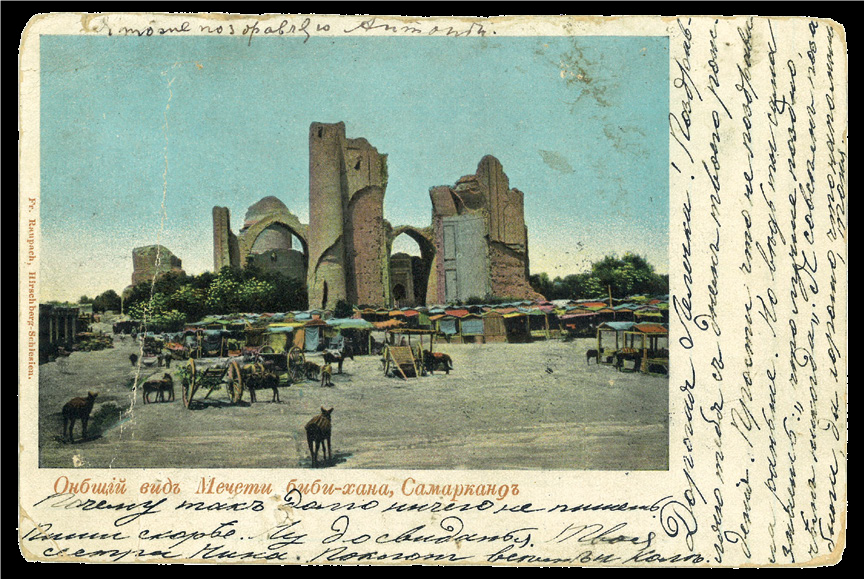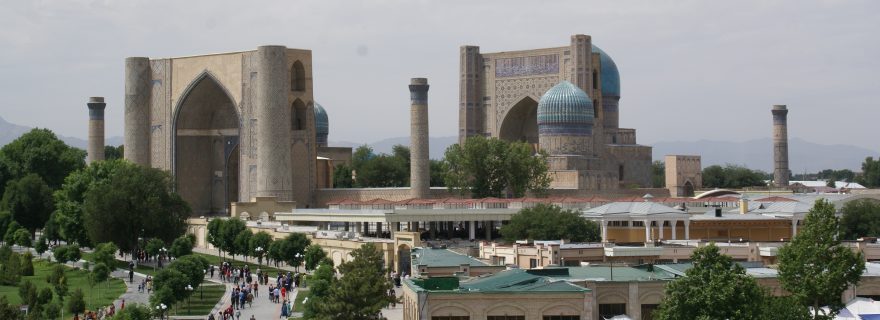Silk Road Cities
The exhibition Silk Road Cities features Islamic architectural monuments in major urban centres along the Silk Roads in Central Asia, documented through vintage photographs, prints and postcards. Opening on 5 September.
The many tourists and pilgrims who visit monuments like the Bibi Khanum mosque in Samarqand today may be under the impression that they are looking at an impressive medieval complex that has withstood the vicissitudes of time more or less unchanged.
The photographs above and below reveal a less romantic reality. We see here the 14th century mosque in a state of delapidation on a postcard of 1905 and the same building in a totally new state on a 21st century photograph.

Samarqand, Bibi Khanum Mosque (1398-1405), view from the east. Postcard published by Fr. Raupach, Hirschberg-Schlesien, 1905. Image from Silk Road Cities (2019), p. 37.
The beautiful monuments of the cities along the Silk Road are indeed in many cases rather recent recreations of the past. On what basis were these monuments regenerated, how, and why exactly?
Those are questions that lay behind the exhibition “Silk Road Cities: Documented through Vintage Photographs, Prints and Postcards” (Oude UB, 5 September-17 October 2019). The exhibition showcases a small part of the unique private collection of Elena Paskaleva, whose research at Leiden University focuses on strategies of preservation and restoration of Timurid monuments in Central Asia.
The images on display represent the urban history and legacy of an immense region, located in the heartlands of the Silk Road, the magical name of a network of trade routes that connected ancient empires. The term ‘Silk Road’ was invented only in the 19th century, by the German scholar Ferdinand von Richthofen. It was an immediate hit and the romantic connotation of the ‘Silk Road’ still continues to inspire travellers, traders and governments. Points in case are China’s New Silk Road initiative and the worldwide bestseller The Silk Roads of Peter Frankopan.
The monuments of the Silk Road cities as showed in the exhibition are all landmarks of premodern empires, ruled by dynasties who had united realms and routes that now fall under the jurisdiction of separate political entities. The monuments represented here on photographs, postcards and prints are today predominantly seen as part of the cultural heritage of different nation states - Uzbekistan, Afghanistan, Iran, Turkmenistan and Kazakhstan. As such, the monuments are subject to different national discourses, strategies and policies.
For example, the buildings commissioned by the 14th century emperor Timur, also known as Tamerlane, play an important role in the national identity discourse of present-day Uzbekistan. This has resulted in certain strategies regarding the restoration of monuments related to him and the Timurid dynasty. Timur himself devoted his life mostly to campaigning east and west from his capital Samarqand in present-day Uzbekistan.
His fame reached far and long: his defeat of the Ottoman Sultan Bayazid in the Battle of Ankara in 1402 served as material for Georg Friedrich Händel’s opera Tamerlano (1724) and Christopher Marlowe’s play Tamburlaine the Great (1587) in Europe. Timur was very keen on leaving an impressive architectural legacy, first and foremost in Samarqand, but also in many other cities of his huge empire. The Bibi Khanum Mosque is an example of this legacy. What Timur initiated was brilliantly taken up by his successors, notably his son Shahrukh (r. 1409-1447), who ruled the empire from Herat, today in Afghanistan.
The items on display in the exhibition show Timurid and other monuments as they were many hundreds of years later, when photography had emerged as a new tool for documentation. Colonial powers, who had by then conquered the region, made good use of this tool . Konstantin von Kaufmann, governor-general of the Russian tsar in Central Asia, commissioned the creation of the Turkestan Album, a huge enterprise for which 1200 photographs, architectural plans, drawings and maps were made between 1865 and 1872. This and other efforts to ‘map’ Central Asia and its inhabitants ultimately resulted in the formation of Soviet republics after the fall of the tsar in 1917.
The photographs, postcards and prints on display in the exhibition show monuments and offer snapshots of people and their daily life, somewhere between the last quarter of the 19th century and the third quarter of the 20th century – a century of many changes. The photographs capture moments from a past that does not seem so far away, even though the appearances of the buildings may have drastically changed between then and now. At the same time however, the photographs portray buildings that are witnesses of a much more distant past: a multi-purpose past that is very much alive in the cultural memory of a great variety of people along the Silk Roads.
***
Exhibition: Silk Road Cities: Documented through Vintage Photographs, Prints and Postcards | Thursday 5 September - Thursday 17 October 2019 | Leiden University, Oude UB, Rapenburg 70.
Please join the festive opening of the exhibition on Thursday 5 September from 17.00-19.00 hrs.




0 Comments